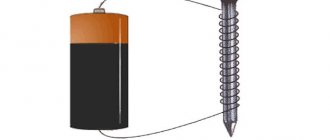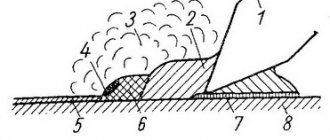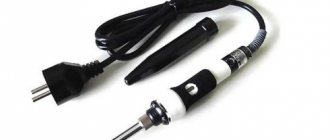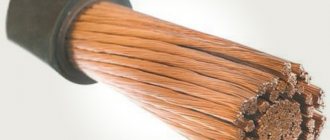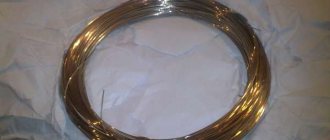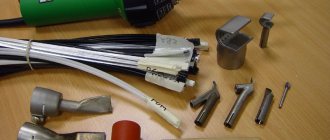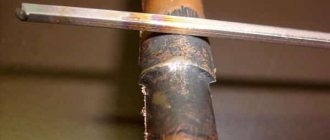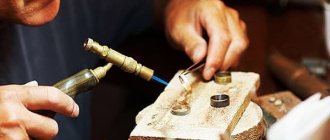Other soldering options: working with copper pipes and various metals
Soldering copper pipes requires some experience in this type of work. Therefore, if a home craftsman takes on such work for the first time, it is worth practicing beforehand so as not to redo a ready-made water supply or heating line several times. Soldering of copper tubes can be done either with hard solder (using a gas torch) or with soft alloys. In the second case, it is appropriate to use a high-power hammer soldering iron for copper pipes.
PHOTO: m-chel.ru Careful and high-quality soldering is the key to the durability of the connection
The nuances of soldering copper pipes: how to do it right
It is best to use rosin as a flux for soldering copper pipes. It is applied in an even layer to the outer surfaces of the pipe, after which the fitting is placed on it. The second part of the line is mounted on its reverse side. Next, the fitting is heated with a gas burner and solder is “laid” along the seams. Under the influence of high temperature it melts, filling the seam and creating a high-quality hermetic connection.
PHOTO: poliasmet.ru Sometimes you have to do without fittings
Soldering copper pipes with your own hands is not too difficult, but this work requires care and precision. Of course, not everything can be explained clearly in words, so we bring to the attention of our dear reader a video on how to solder copper with a gas torch, from which everything will become more clear.
Having dealt with the question of how to solder copper tubes at home, you can move on to the next problem, namely soldering non-identical metals (copper with aluminum, iron or stainless steel).
How to solder copper wire to aluminum
Soldering aluminum and copper is a rather complex process. It should be noted that the same solder is unlikely to be suitable for aluminum as for copper, and vice versa. It is much easier to combine these metals using a steel coupling. Although today the manufacturer offers special solders and fluxes for such purposes, their cost is significant, which makes such work unprofitable.
PHOTO: kak-eto-sdelat.info Soldering copper and aluminum is quite difficult
The whole problem lies in the conflict between copper and aluminum. They have different refractoriness and density. In addition, when interacting with copper, aluminum begins to oxidize strongly. This process is especially accelerated when electric current passes through the connection. Therefore, if it is necessary to connect copper and aluminum wires, it is best to use WAGO self-clamping terminal blocks, which contain Alu Plus contact paste inside. It is this that removes oxide from aluminum, prevents its subsequent appearance and promotes normal contact with copper conductors.
Having figured out how to solder copper to aluminum, you can move on to harder metals.
PHOTO: mastergrad.com Sometimes you can’t do without such a connection
How to solder copper and stainless steel
When soldering copper to stainless steel, it is not the solder material itself that plays a big role, but the tool used, although a lot depends on the consumables. The most acceptable materials in this case are:
- copper-phosphorus solder;
- tin-silver (Castolin 157);
- radio engineering.
Some craftsmen claim that with the right approach to work, even the most common solder based on tin and lead will do. The main thing is the mandatory use of flux (borax, soldering acid), thorough heating and only after this soldering (applying solder).
PHOTO: cusi3.ru Complex soldering of copper and stainless steel
Such connections are rare, and therefore specialized solders for such purposes are quite expensive.
Soldering copper with iron - is it possible?
This option is possible, but subject to certain conditions. For example, a simple propane torch is no longer suitable as a heater. Propane with oxygen must be used. You need to use borax as a flux, but brass will be the solder. Only in this case can we hope for a normal result. It is not difficult to buy solder for soldering copper with iron or stainless steel. The main thing is to understand whether the extra costs will be justified.
PHOTO: svarkavol.ru Soldering copper and iron tubes is also possible
And now we propose to look at how carefully home craftsmen can carry out the work of soldering pipes of mains for various purposes.
Preparation for soldering copper with aluminum, brass, stainless steel, iron
The preparatory period, which includes the acquisition of the necessary devices, materials, personal protective equipment, and the soldering procedure itself.
There are two ways to solder copper to copper: high and low temperature. The first involves heating the metal to 900°C, and is used for pipelines with high pressure or temperature load. For high-temperature soldering, materials intended for this are used: hard solder in the form of rods (the melting point of such solder is about 900°C) and hard-melting flux.
In order to solder copper using the low-temperature method, it is sufficient to heat the metal to 600°C (usually 300–380°C), which is achievable in domestic conditions. For the procedure, soft solder is used for soldering copper and brass in the form of a wire or rod with a cross-section of up to 3 mm and a more fusible flux. Solder is an alloy of tin, which is more than 97%, with other metals: copper, selenium, silver, antimony.
Why do you need flux? Correctly soldering copper pipes can only be done with flux - a special paste-like composition (with zinc chloride), which is applied to the surface of the connected sections of the pipe in a wide strip. It performs several functions:
- prevents the process of metal oxidation by removing oxygen;
- improves the adhesion of solder to copper;
- is an indicator of sufficient heating of the metal, signals when to apply solder and solder the copper;
- promotes uniform spreading of solder along the joint.
Safety precautions. Despite the simplicity of the process, soldering copper pipes must comply with safety rules. The danger of burns is posed not only by the burner flame itself, but also by the heated metal. Copper conducts heat well, so during operation, not only the area on which solder is placed and welding is carried out, but also the entire pipe becomes very hot, and it cools down slowly. If you need to solder copper tubing that is not already built into the piping system, preparation involves placing it on non-flammable supports where it can take a long time to cool. Before touching the welded metal from its place, you should wait until it cools completely.
The immediate danger is the open flame of the burner, so you need to purchase a tool that is convenient to work with: preferably with a movable nozzle on a long hose
How to solder copper with hard and soft solder
Copper products are found everywhere in different areas of life. For example, it is used to create strong and durable heating and water supply systems. But to connect the two elements, experts resort to a special technology - soldering copper pipes. The procedure requires suitable tools and materials, as well as knowledge. Since it has certain features that a beginner may not know about.
To solder copper, the master needs to have with him a composition such as solder. This thermoplastic substance seals the surface of the product and, under the influence of high temperature, melts, spreading over the entire joint. But as soon as it cools, it hardens and securely holds the products together.
The result is one item that has a long service life, withstands high loads, pressure and temperature changes, and is not afraid of ultraviolet radiation.
Safety precautions when soldering copper
It should be taken into account that the heat conductivity of copper is very high, as a result of which it is not recommended to solder parts while holding them in your hands without protection; this will most likely result in burns. Parts shorter than 30 cm are handled exclusively with pliers or in protective gloves. If during the soldering process flux drips onto exposed parts of the body, you need to immediately wash it off with soap and water, since, in addition to thermal burns, you can get a chemical burn.
For any work with open fire and hot metal, as well as flux that contains acid, synthetic clothing is undesirable, since such fabric ignites and melts much faster than others. Be sure to ventilate when working; smoke from burnt flux is harmful.
If you have absolutely no soldering skills, it is advisable to practice on scraps of pipes or wires before performing important work. There are few difficulties in this work, and 2-3 times, as a rule, are enough to master all the basic techniques. If the plumbing system is being assembled, it is recommended to pre-assemble it on the floor before installing everything in place. After assembly and soldering, the system should be thoroughly rinsed with hot, clean water to remove any flux and solder from the inside of the pipes.
Plumbing or heating systems made from copper pipes are expensive, but they are strong and durable. Since copper has a high thermal conductivity coefficient, good anti-corrosion and antibacterial properties, pipelines made from it are efficient and durable. Soldering copper at home is not difficult: a socket-coupling is put on the pipes, and then the seam is sealed. Instead of using a flare, sometimes they widen the end of one pipe and insert another into it. This connection is convenient because it does not require fittings, and the service life is equal to the life of the pipes themselves.
What tools and materials are needed
Soldering is carried out not only at industrial facilities, but also at home. To do this, you need to prepare the following tools and materials:
- electric soldering iron or gas burner;
- pipe cutter;
- solder;
- flux;
- brush and steel brush.
How exactly to connect the products depends on the convenience and preference of the master. But the power of the device is selected in accordance with the melting temperature of the solder. Flux can be liquid or solid; each type has individual differences that should be taken into account. If the material is used in the form of a thickened mixture, then it is applied to the joint, both before and after the connection. Flux is needed to protect the surface from oxidation, promote solder flow and improve adhesion.
Soldering process
It consists of performing sequential operations:
- the pipe is cut into pieces of the required sizes, which are marked for convenience - supply or return;
- a chamfer is removed from the edge;
- the edges are cleaned by 2 cm: the outer ones on the pipe, as well as the inner ones in the socket;
- Flux is applied in a strip along the cleaned surfaces (external and internal);
- the connection is assembled: the pipe is inserted into the socket;
- excess flux is removed with a paper napkin, but not completely - an edge of 1–2 mm is left;
- the burner is ignited, the flame is brought to the junction;
- the surface is heated for 10–15 seconds to a certain temperature - the flux should acquire a tin color;
- Solder is placed on top of the joint; when heated, it will be drawn into the joint and spread along the seam, filling it.
If the connection joint has not been cleared of bristles or dust, and as a result the soldered seam of the copper water pipe leaks, then the tightness can be restored using one of two methods:
Using a soldering iron
- the surface is cleaned, treated with phosphoric acid, heated with a soldering iron, and tin is applied;
- using a torch: flux is applied to the cleaned surface, heated, solder is applied, and melted.
How to properly solder copper with a gas torch
You can solder a copper tube as follows:
- Clean the soldering area with a fine file, sandpaper or wire brush.
- Grind rosin and sprinkle the soldering area.
- Heat the tube over a gas flame until the rosin melts.
- Place POS-30 or 40 solder and melt it with a soldering iron, spreading it over the surface.
In everyday life, copper processing is encountered not only when it is necessary to solder copper heating or water pipes, but also in car repair if a crack or leak appears on the car radiator. In this case, you do the soldering of the copper radiator yourself. Instead of a gas torch, car enthusiasts use a powerful 250 W electric soldering iron for copper pipes. To strip copper, use sandpaper or a metal brush, and for soldering tin, rosin or orthophosphoric acid is used as soldering acid.
Soldering with a soldering iron at home
Soldering copper with a soldering iron is easier than using a torch. The procedure looks like this:
- The surface of the radiator is cleaned with fine-grained sandpaper or a brush.
- A few drops of acid are evenly applied to the edges of the damaged area.
- The crack is heated with an electric soldering iron and solder is applied. Having melted, the tin fills the hole.
Independent soldering of copper heating or water supply pipes, repairing cracks in radiators is a simple technology process that can be done at home with a small set of tools.
WATCH THE VIDEO
Soldering copper at home is something every man can do.
Types of fluxes and solders, features of working with them
Craftsmen know a variety of hard and soft substances that ensure high-quality soldering of metal products. 95% use tin, which is a low-temperature composition with slightly worse technical parameters. But it is valued for the fact that work can be carried out at any temperature without reducing the strength of the products being joined.
Connecting elements also include silver, which has excellent technological properties. Craftsmen often use three-component compositions of silver, tin and copper. Often, materials used in low-temperature soldering contain zinc chloride.
The advantage of soft solders is that they cover a larger area when applied to the surface of the part. They provide high strength and reliability.
Soft solders
Soft solder is used in the installation of water supply and heating networks, where the pipe diameter reaches 10 cm and the water temperature does not exceed 130 degrees. These types include:
- lead-tin type;
- with low tin content;
- special and fusible.
How to solder steel: nuances
In order to start soldering steel, you need to choose the appropriate method. This takes into account:
- oxide film resistance;
- interaction of steel and solder;
- change in the characteristics of steel after the thermal soldering process.
Oxides are very easily removed when carbon steel is soldered. It is much more difficult to remove the oxide film when working with alloy steel, which contains chromium, aluminum, titanium and silicon.
Hard soldering diagram.
The fact is that after heating, poorly soluble oxides М203, М203 appear on the surface of the steel.
To solder steel, use solders, which include:
These materials have little effect on the properties of steel; they practically do not dissolve it.
Why do you need solder paste?
Solder paste is a pasty mass consisting of small particles of solder, flux and special additives. Flux paste is used in industry when soldering elements on printed circuit boards. The paste is selected according to certain conditions:
- after application there should be easily removable particles;
- the substance must maintain viscosity and stickiness;
- do not have a negative impact on the surface being treated;
- do not leak onto clothing during melting.
How to work with the paste depends on the type and size of solder contained in its composition. The material also differs in the type of flux (rosin, water-washable, no-clean). It is necessary to hold small parts in place and facilitate the joining process.
How to solder parts from tin?
The standard method of soldering tin is to use solder, which contains a large amount of tin, flux and a soldering iron with an awl.
Professionals advise using the following brands of solder:
This choice of solder is associated with the chemical characteristics of the materials when soldering with tin is performed. In addition to tin, these solders also contain:
Brands and properties of solders.
These brands of solders differ in shear resistance due to a certain amount of impurities. In addition, they increase the tensile strength of the seam after soldering is completed. If there is not enough tin in the solder, then the amount of antimony increases.
In some cases, POS 90 with a large amount of lead is used. For galvanized material, a slightly different approach is taken.
To solder galvanized iron, flux must be present. It plays the role of a chemical oxidizing agent and at the same time a solvent. Thanks to flux, the oxidation process disappears. On top of that, the metal is wetted with iron, resulting in a high quality weld. Most often, hydrochloric acid and rosin are used as flux.
Soldering technology
The process is quite simple, therefore, when it is necessary to connect something at home, the owner does the soldering with his own hands and without the involvement of specialists. But still, you can’t do without the preparatory stage.
It determines how high-quality and reliable the connection will be. First of all, you should pay attention to the cut of the part, which should be strictly vertical, without burrs, with even and smooth edges. If you find the slightest defects, you should take sandpaper and rub it over the surface until the defects disappear.
If two copper pipes are connected, then, having brought the cut to an ideal state, it is necessary to insert it into the fitting and then remove it. The part that came into contact with the fitting must be cleaned of oxidation. The next step is applying flux. There is nothing complicated about this, you just need to run the brush over the entire part, paying special attention to the joint.
Then the elements are connected to each other and firmly fixed. Further actions depend on what is being used for soldering - a gas torch or a soldering iron. Considering that the parts must be stationary, an assistant will be required. He will be the one to hold them, but if one is not found, you need to manage and do it yourself.
When something needs to be soldered at home, a solid compound is most often used. But the master can purchase special pastes. With the correct choice of compositions, it is possible to connect two pipelines or radio components as accurately and firmly as possible.
Soldering is performed at either high or low temperature. In the first case, the process is distinguished by high strength of the seam, and the connected area also gains heat resistance. Which is very important if it later serves as part of various communications. But high-temperature soldering is not allowed on threaded connections. Most often this process is performed with a propane-filled torch.
When low-temperature soldering is used, a soft compound, paste or gel is used. It is most suitable for a beginner master because it is simple and easy. In this type of process, the temperature does not rise above 425 degrees, so it is even possible to use a soldering iron, which is found in almost every home.
Working with a soldering iron
Every person has seen a soldering iron at least once in their life, and many constantly work with it. Therefore, they will not see anything complicated in soldering copper products with this tool. The whole essence of the process is that the solder located between the two parts is heated with a soldering iron until it begins to melt.
When it hardens, the two parts will be securely fastened into one. To solder efficiently, it is necessary to distribute the substance evenly over the entire surface, filling every gap. It is important to choose exactly the material that can withstand the high temperature of the soldering iron.
Working with the burner
The tool is turned on when the two parts are already connected to each other. You should not hold it near the joint for too long, since the combustion temperature is several thousand degrees. While you only need to heat a certain place to 250-300 degrees.
This will take 20-30 seconds. As soon as the flux changes color to dark, the compound to be joined is introduced. Important! The burner or hair dryer should be placed in the middle to cover the entire joint area.
What is needed for soldering copper pipes
Soldering copper pipes, which is not difficult to do with your own hands, does not require expensive equipment or any special materials. In order to carry it out correctly, you will need the following equipment.
A burner that will heat the solder and the section of pipes where they will be connected. Such a burner is usually supplied with propane gas, the pressure of which is regulated using a welding reducer. Special device for cutting copper pipes. Since products made from this metal are very soft, they should be cut gently enough so as not to crush the walls. The modern market offers pipe cutters of various models, differing in both their functionality and technical capabilities.
The design of individual models of such devices, which is important, allows them to be used even for working in hard-to-reach places. A pipe expander is a device that allows you to expand the diameter of a copper pipe, which is necessary in order to perform soldering better. Various systems mounted from copper pipes use elements of the same cross-section, and in order to connect them efficiently, it is necessary to slightly increase the diameter of one of the elements being connected
This is precisely the problem that a device such as a pipe expander solves.
Copper pipe flaring kit
A device for chamfering the ends of copper pipes. After trimming, burrs remain on the ends of the parts, which can interfere with obtaining a high-quality and reliable connection. To remove them and give the ends of the pipes the required configuration, a bevel remover is used before soldering. There are two main types of chamfering devices on the market today: those placed in a round body and those made in the form of a pencil. More convenient to use, but also more expensive, are round devices that can process soft copper pipes with a diameter of no more than 36 mm. To properly prepare copper pipes for soldering, it is necessary to remove all contaminants and oxides from their surface. For these purposes, brushes and brushes are used, the bristles of which are made of steel wire. Typically, brazing of copper pipes is performed with hard solder, which can be high- or low-temperature. High-temperature solder is copper wire containing about 6% phosphorus. Such wire melts at a temperature of 700 degrees, while for its low-temperature type (tin wire) 350 degrees is sufficient. The technology for soldering copper pipes involves the use of special fluxes and pastes that perform a protective function. Such fluxes not only protect the seam being formed from the formation of air bubbles in it, but also significantly improve the adhesion of the solder to the pipe material.
In addition to flux, solder and other basic elements, to solder copper pipes you will also need additional tools, which can be found in every workshop or garage. To solder or cook copper products, additionally prepare:
- regular marker;
- roulette;
- building level;
- a small brush with stiff bristles;
- hammer.
Before starting work, it is also important to decide how to solder copper pipes. There can be two main options: soldering copper with hard solder (used less frequently) and using soft solder
When addressing this issue, it is important to assume that there are requirements for the use of one or another type of solder. Thus, hard solders are used for soldering elements of refrigeration units and air conditioners. In all other cases (water supply systems, heating systems, etc.) tin wire can be used. But no matter what technology is chosen, it should be remembered that flux is necessary in any case.
Cleaners for cleaning the inner surface of a copper pipe before soldering
Soldering with silver solder
When you need to solder parts at home, silver solder is often used. It is beneficial because you can create it yourself. But it should not be used alone, in combination with zinc and copper.
Treated with this solder, the seam will be very strong and neat. The percentage of components is controlled by GOST 19746 74. But you can find out exactly what types of substances to use from the instructions of experienced craftsmen or those included with the products being connected.
Features of soldering with soft and hard solders
The connection of copper pipes has a number of characteristic features. They are especially pronounced when using different materials.
Soldering of links with low-melting solder is carried out at a temperature of 175–315ᵒC. Soldering with solid compounds is carried out by heating the joint to a temperature of 650–815ᵒC.
Soft alloy soldering is used for soldering copper pipes with an internal diameter of up to 22 mm, and hard alloy soldering with a diameter of 22 mm or more.
Soft and hard solders - description
When sufficiently heated, the applied flux layer boils. When soft solder melts, a molten drop is formed, which plays an important role in creating a strong pipe connection. Boiling flux pushes the molten composition out of the joint space. Under the action of capillary forces, the solder alloy is drawn into the joint as it cools.
When butt brazing, a thin spacer of soft metal is inserted between the elements being soldered. The parts to be connected are securely and firmly fixed with a guide gasket.
A simple technique for soldering copper pipes and the availability of all materials allows you to do this work yourself at home.
Related video: Soldering copper pipes “my experience”
Selection of questions
- Mikhail, Lipetsk — What discs should I use for cutting metal?
- Ivan, Moscow - What is the GOST for rolled sheet steel?
- Maxim, Tver - Which racks for storing rolled metal products are better?
- Vladimir, Novosibirsk — What does ultrasonic processing of metals without the use of abrasives mean?
- Valery, Moscow - How to forge a knife from a bearing with your own hands?
- Stanislav, Voronezh — What equipment is used for the production of galvanized steel air ducts?
How to solder copper and stainless steel
If you need to solder copper to another metal, such as steel, you will have to work hard. This process is not easy, but it is quite feasible. This is explained by the fact that stainless steel interacts poorly with other metals and is difficult to heat treat.
When two different products are combined, you need to find an average composition that suits both at the same time. In such cases, you have to sacrifice quality and it is not even necessary to use flux. But it is important to carry out preparation, tinning and other soldering steps.
The need for a connection often arises at home. Joining stainless steel and copper requires little time and a conventional gas torch is sufficient. Therefore, having decided on the tool and solder, you should clean the surface of both joints and prepare flux. Then tinning the bonding area and applying flux. After which the two parts are connected, and the resulting seam is coated with solder.
The next stage is its uniform heating with a burner. Once the solder has spread, the product is left to cool naturally.
How to solder copper to iron
Often there is a need to fasten steel parts without drilling and without welding. Soldering steel will help. But how to do it correctly, because there are special nuances here. A few recommendations from experts.
What kind of steel solders well?
Some grades of steel lend themselves well to soldering, while others are soldered with great difficulty and do not want to be combined with any solder or with any flux. As a rule, soft steels "for nails" are easy to solder.
At the everyday level, this can also be explained by the fact that the material is dotted with microscopic craters and irregularities. But there are also electrical grades that are especially hard and elastic, and are used for shafts and precision mechanics.
It depends on your luck here...
The question is that it is impossible for a home craftsman to determine the brand by eye. You can only find out how well a given part made of steel, or an alloy close to it, is soldered by experimentation.
How to make a tin connection - procedure
It all depends on how successfully the part can be tinned and how strong the contact of the tin solder with the steel is. In order for the contact to be satisfactory, if possible at all, the following must be done:
- steel stripping, chemical stripping under solder;
- heating the part to the melting temperature of the solder, keeping the solder on the part under flux for some time in a fluid state.
Cleaning the steel is first done mechanically, using sandpaper, to remove layers of rust and dirt. Then a composition that reacts well with iron oxides is used as a flux.
The most harmless to use, but effective in this case, is orthophosphoric acid, which can be easily purchased at a car store as a “rust cleaner.”
The required power of heating devices depends entirely on the mass of the parts.
The process of soldering two steel parts
If you need to solder two large nails, then the power of one soldering iron 100 W will not be enough.
To heat up a large nail or a similar weight steel part clamped in a vice, you need to use a hair dryer. Or a gas burner.
You will also need cotton wool on a stick to supply flux to the heating zone, and a soldering iron of 50 W or more.
- The sanded steel is heated with a burner.
- Phosphoric acid is applied to the hot part and molten tin solder is immediately applied with a soldering iron.
As a rule, steel parts that can be soldered develop a very strong bond with tin, i.e. When the metal is coated, it is tinned.
The same is repeated with another detail. Then the two parts located together are heated, and additional solder is applied to the contact area with a soldering iron.
How strong is the soldering of steel, can it be made stronger?
The strength of such a connection will be determined by many factors:
- strength of bond between solder and metal,
- connection area,
- direction of the load in relation to the welded planes.
But in any case, the strength of tin soldering cannot be compared with what is commonly understood as the strength characteristic of steel or “metal welding”.
You can strengthen it by using another solder - special strong and more refractory compounds containing silver, zinc, copper, etc.
Another direction for increasing strength is to cover with solder not only the plane, but also the sidewalls of the part - covering the part with solder. Then the pull-off resistance under multidirectional loads will be greater.
Extra strong soldering, special solders
To use compounds that provide a strong connection with steel, with its own melting point of about 800 - 900 degrees, you need to use a graphite crucible.
The work should only be carried out by specialists in metal smelting.
It is necessary to know the basics of metal melting, the procedure for handling melts and safety precautions.
In general, soldering of steel with heavy-duty solders is performed at specialized enterprises.
Possible solder composition:
- 55% zinc, 45% copper, some silicon to increase fluidity.
The composition is melted under a layer of coal in a graphite crucible. Steel parts to be soldered are heated with a gas burner.
Phosphoric acid is used as a flux. The melt is fed to the parts.
As a rule, tinning and soldering are carried out during one heating of both the parts and the solder.
But such soldering of steel is more complex than simple welding...
How to Solder Copper to Metal - Metalworker's Guide
When joining copper products, various tools and equipment are used, without which the soldering process would not be possible. The main tool is a soldering iron. In addition, you can use a gas burner or special ovens.
At home, it is preferable to use soldering of copper products; this option is the simplest and fastest compared to cooking. In addition, you do not need special equipment to carry out the fastening.
If all the rules and conditions of the technological process are observed, a strong and reliable connection of elements can be obtained, increasing resistance to various loads.
To ensure that soldering at home does not cause difficulties, first of all you need to take care of the basic tools that will be involved in this process:
- pipe cutter;
- chamfer;
- pipe expander;
- steel brush;
- steel brush;
- solder;
- burner or hair dryer.
For a tubular device, a method is used when the element is immersed in a composition of salt and solder. Salt acts as a heat source and replaces the functions of flux. Therefore, additional flux is not needed.
In addition to this method, there are several other soldering options that deserve attention.
Soldering copper
Brazing
The most common method of soldering at home is brazing copper.
This is explained by the properties of copper, which melts easily at low temperatures. A soldering iron or gas torch is quite suitable as a tool.
Soldering copper is a bit similar to the welding process, but still has some minor differences:
- When soldering parts, an additional substance, solder, is used, which connects these elements. This is possible due to the properties of solder, which has a low melting point.
- The most common materials for soldering parts are nickel and tin. These are affordable and simple components that are used in most cases. As for industrial use, other types of solder are used for these purposes, but for home use they are quite expensive and, therefore, unprofitable.
- To solder copper products, you must first melt the solder until it reaches the desired consistency in order to apply it to the place where the elements are soldered. After this, you should wait until the connection cools completely.
If all the nuances of the process are carried out exactly, then such a connection will be strong and durable.
Soldering in ovens
Soldering of copper in furnaces is carried out under production conditions. This process ensures uniform heating of the parts, completely eliminating its deformation.
Tin or an alloy of tin and lead is used as an alloy; a composition of rosin and alcohol, or a composition of ammonium chloride or zinc, is used as a flux.
When using solder with a silver base, fluxes are used, which are based on compounds of fluorine, potassium and boron.
These fluxes best clean the bonded surfaces from the oxide film, this will allow the alloy to be perfectly distributed over the entire surface.
Flux Soldering
This procedure has one big disadvantage, it is the implementation of a hermetic bond.
Excess flux creates additional pockets that are subject to corrosion; as a result, soldering is performed in neutral conditions or in a reducing gas environment. To solder in nitrogen, the required temperature must reach 750–800 degrees.
Vacuum soldering
Vacuum furnace for copper soldering
Vacuum soldering is used for many metals, copper is no exception. Copper soldering is carried out in specialized furnaces, or containers, which are then placed in the furnace.
Despite the complex equipment, this option is considered the most effective by all criteria. Bonding of copper products is done with soft solder or pure tin.
You can use other types, for example, silver alloys, using a flux of rosin-alcohol solution.
In order to use cadmium solder, it is necessary to prepare a special tool and stock up on the necessary knowledge in this area, because the manufacturability of this material is much lower than that of tin-lead tinols.
Basic mistakes when soldering yourself
Most often, it is haste that leads to the fact that the connection of two elements is unsuccessful. Because they forget to inspect the surface of the parts being connected. The first action aimed at correcting an error is checking for the absence of defects. They could appear when cutting parts.
How reliable the seam will be depends on the cleanliness of the surface. Therefore, it is still worth brushing off even invisible specks of dust. One of the most basic mistakes is made when applying flux. The master may forget to process a small area of the product. And it will cause the proper connection to fail.
It is also important to monitor the temperature of the torch or soldering iron, since overheating of the element being processed leads to combustion of the flux. But insufficient melting point is also harmful. In this case, the connecting compounds do not soften or stick.
How to solder correctly
To reliably solder copper wires, you need to prepare a soldering iron. If you do not tin the tip before work, the solder will not stick, but will roll off the rod in balls. This happens because the tip is covered with a layer of copper oxide and carbon deposits formed during previous soldering.
Preparing the soldering iron
For ease of work, some specialists sharpen the tip with a flat file to give it the shape of a spatula or flat screwdriver. The sharpening angle should be 45-60 degrees.
A non-burning tip (eternal) cannot be sharpened under any circumstances; special sponges are used for it.
The mechanically cleaned tip must be heated and then tinned. To do this, it is coated with flux.
If the flux is solid (rosin), simply immerse the tip in it. The rosin will melt and cover the heated surface. After this, you need to touch the solder bar with a soldering iron and heat it up. The molten solder will coat the tip, protecting it from further oxidation.
The procedure for tinning a soldering iron must be repeated as carbon deposits form on it. This happens because the temperature of the tip is much higher than the melting point of the solder, and over time it begins to burn. To reduce the likelihood of this happening, it is recommended to use a soldering iron with temperature control.
Preparing the wires
The copper wires to be connected also need to be prepared for soldering. First, remove the insulation from the ends at a distance of about 4 cm, strip them, twist them together and tinning them. Copper wires can be tinned as follows:
- heat the twist with a soldering iron;
- coat with flux;
- Apply a small amount of solder, spreading it over the surface of the wire.
The actions are similar to those performed when tinning a soldering iron tip. If you are going to solder stranded copper wires, then you must stock up on liquid flux, since it will be very difficult to cover the entire surface of the copper “hairs” with molten solid rosin. To get a quality connection, you need to heat the stranded wire and then dip it in liquid flux, which will wet the entire surface intended for soldering.
Further, soldering of stranded and single-core copper wires is carried out in the same way. The two or more conductors being joined are heated together and solder is applied to them. After applying it, it is necessary to ensure that the joint remains motionless while it cools. It is not allowed to accelerate cooling by wetting it or blowing air on it.
Theory
Copper is one of the oldest metals, which is used by people to create various decorations, devices and communications. It is characterized by high plasticity and pinkish-red color, sometimes with a golden tint. In the household, copper is most often used in water pipes and heating, because it does not corrode and is resistant to temperature changes.
Photo - copper connections
There are many types of soldering; capillary soldering is used for copper. It allows you to connect two parts of a pipeline or radio components as accurately and firmly as possible. This thermal effect is also divided into:
High-temperature soldering is characterized by higher weld strength. In addition, it allows the connection to be thermally stable, which is very important for various communications. But at the same time, this type of work is not used on threaded connections. To carry out such soldering, special equipment is required - a burner with piezo ignition and acetyl, propane.
Photo - copper elements
Low temperature is used when working with soft solders (pastes, gels). The main advantage of this technique is the simplicity and ease of work. It is carried out at a temperature lower than 425 degrees, so soldering can even be done with a soldering iron. It lies in the fact that, under the influence of a certain temperature, the solder applied to the gap between the part and the area being connected expands, closing the gap.
Copper soldering: what is useful to know?
Soldering copper, as well as its alloys, is a fairly common procedure nowadays, since it is not uncommon for some home equipment to be made from this material. Thus, knowledge regarding soldering copper wires of electrical wiring, heating radiators, and any small household parts may be useful. Copper soldering of parts is a popular service of numerous companies engaged in repair and soldering of products made of various metals.
The Benefits of Copper: A Brief Course in Materials Science
Technically pure copper boasts excellent electrical conductivity as well as thermal conductivity. Copper also has a huge advantage because it is highly resistant to corrosion. Copper is a relatively strong and also ductile material.
With a decrease in gases, the ductility of copper increases to 62%. At elevated temperatures, the strength of the metal declines, while its ductility increases.
A remarkable property of copper is that it is capable of maintaining high ductility up to the temperature of liquid helium (-269 degrees C).
In order to increase the strength of copper as a material, as well as to give it positive properties, it is alloyed with all kinds of additives. It is worth noting that copper-based alloys boast significant mechanical properties and much more.
Materials, equipment and methods
Of course, when connecting copper products, special consumables and auxiliary materials, tools and equipment will be required. In most cases, the main tool during soldering is a soldering iron. Gas equipment (burner), or the use of special furnaces, as well as immersion in solder (tinol) can also be used.
Low-temperature solder is used during soldering due to the general availability of the material, as well as ease of use. However, there is one significant limitation when working with a soldering iron, according to which this tool can only be used with thin-walled parts at temperatures up to 350 degrees. C. Massive metal parts, due to their high thermal conductivity, are connected with gas burners.
For tubular heat exchangers, soldering is used by immersion in molten solders and salts. Salts serve as a source of heat and act as a flux, and therefore there is no additional need for the use of flux. During soldering using the method of immersion in a bath where the solder is located, the fluxed parts are heated in the molten solder, which fills all the gaps.
Capillary soldering
Capillary soldering of the material in question using low-temperature tinols is performed at gaps from 0.05 to 0.5 millimeters, as well as at temperatures from 650 to 900 degrees. C in argon or vacuum.
Capillary soldering of compounds obtained using indium, gallium, lova, POS40 and POS61 are not distinguished by excellent strength, since their tensile strength ranges from 40 to 70 MPa. During the procedure of joining copper with lead, a seam is formed that is not very strong, but at the same time ductile.
By using Pb-Ag-Sn-Ni system solder, it becomes possible to provide a connection with a tensile strength of 140 MPa with high ductility.
Soldering steel at home
Soldering of various metals is used in many industries today. Most metals are joined using tin-lead solders, and they are mostly suitable for bonding copper. To solder steel, you will need a certain tool, as well as materials and equipment that we will use at home. Thus, to connect steel products, you need to prepare refractory solder at home.
You will need the following:
- Zinc;
- Copper;
- Silicon;
- Nickel;
- Charcoal;
- Graphite crucible;
- Gas-burner;
- The soldering tool is more powerful.
Procedure:
- To prepare the first type of refractory tinol, you will need to prepare a graphite crucible, copper, zinc and charcoal. Next, you need to place a copper and zinc container in a ratio of 45% to 5%, respectively. Then you should melt the mixture under a layer of charcoal. In order to increase the fluidity of tinol, 0.3% silicon is added. After melting, the mixture for joining the steel must be stirred and poured into small molds. Such solder is available for soldering steel in the temperature range from 850 to 880 degrees. WITH.
- For a higher temperature for soldering steel, you need to change the proportion of copper and zinc composition and mix 60% with 40%, respectively. The flux can be a rust converter containing phosphoric acid or zinc chloride. Flux should be used for processing steel in conjunction with washing with a soap solution.
- To solder large steel, it needs to be preheated. A gas tool (torch) is used for this.
- The steel surface is cleaned and then treated with a solvent.
- The soldering iron tip is also cleaned and then rubbed with a piece of aluminum. Soldering of steel is carried out with a heated pin using gentle movements.
Soldering tools
Before starting work, you need to prepare special tools and devices for soldering copper connections. You will need:
- Gas or oxygen torch for soldering copper (with nitrogen, acetate, etc.);
- Solder (for capillary soldering according to GOST R 52955-2008);
- A brush (hard, but not metal) and abrasive paper for stripping copper connections;
- Fittings or other connected elements;
- Soldering flux.
It should be noted that if the work is done on pipe connections, then you may also need a chamfer, an expander, or a special cutting device. All of these fixtures can be found at a professional plumber so you don't have to buy them.
Photo - burner
Burners for copper are: professional (for working with hard solders), for heating pipes and soldering with soft pastes, semi-professional or combined. There are also special hair dryers that are used for soft soldering. They allow you to quickly heat the joint at temperatures up to 650 degrees.
- Solid. They are represented by rods of a certain diameter, which is selected based on a certain gap when connecting. It is used when connecting copper and iron in water supply systems, gas supply and air conditioning systems. This solder can be with phosphorus or silver;
Photo - hard solder - Soft ones can be either in the form of paste or thin wire up to 3 mm in diameter. They are produced with lead and tin. Also sometimes the process is carried out with orthophosphoric acid.
Also, to join copper alloys, it is necessary to use flux. It performs several useful functions: it promotes better spreading of solder over the metal, protects the processing area from an oxygen film, and cleans the seam from oxide. Fluxes come with borax (for various high-temperature solders), used for medium-melting compounds of gold, copper, bronze, cast iron, and stainless steel. Outwardly, they look like a paste and are applied with a special brush.
Photo - flux paste
Brushes and abrasive sheets (sandpaper) are needed to remove solder residues from the seam after finishing work. Fittings are selected based on the required connections (they can be branching, corner, curved, etc.).
Photo - soldering iron
Preparation for soldering copper with aluminum, brass, stainless steel, iron
The preparatory period, which includes the acquisition of the necessary devices, materials, personal protective equipment, and the soldering procedure itself.
There are two ways to solder copper to copper: high and low temperature. The first involves heating the metal to 900°C, and is used for pipelines with high pressure or temperature load. For high-temperature soldering, materials intended for this are used: hard solder in the form of rods (the melting point of such solder is about 900°C) and hard-melting flux.
In order to solder copper using the low-temperature method, it is sufficient to heat the metal to 600°C (usually 300–380°C), which is achievable in domestic conditions. For the procedure, soft solder is used for soldering copper and brass in the form of a wire or rod with a cross-section of up to 3 mm and a more fusible flux. Solder is an alloy of tin, which is more than 97%, with other metals: copper, selenium, silver, antimony.
Why do you need flux? Correctly soldering copper pipes can only be done with flux - a special paste-like composition (with zinc chloride), which is applied to the surface of the connected sections of the pipe in a wide strip. It performs several functions:
- prevents the process of metal oxidation by removing oxygen;
- improves the adhesion of solder to copper;
- is an indicator of sufficient heating of the metal, signals when to apply solder and solder the copper;
- promotes uniform spreading of solder along the joint.
Safety precautions. Despite the simplicity of the process, soldering copper pipes must comply with safety rules. The danger of burns is posed not only by the burner flame itself, but also by the heated metal. Copper conducts heat well, so during operation, not only the area on which solder is placed and welding is carried out, but also the entire pipe becomes very hot, and it cools down slowly. If you need to solder copper tubing that is not already built into the piping system, preparation involves placing it on non-flammable supports where it can take a long time to cool. Before touching the welded metal from its place, you should wait until it cools completely.
The immediate danger is the open flame of the burner, so you need to purchase a tool that is convenient to work with: preferably with a movable nozzle on a long hose
Welding
Let's look at how copper pipe soldering is done with your own hands:
- Any technology involves pipe preparation. You will need to cut the communication to the desired size and trim the ends with a bevel gun. This is necessary so that the next element is not damaged during connection and the maximum rigid adhesion of the parts is obtained;
- Soldering flux is applied to the edge of the copper pipe, and it is also applied to the fitting or other pipe. Afterwards you need to carefully insert the communications into each other. If soldering is done with self-fluxing solder or an electrode, then flux does not need to be used;
- The selected solder is inserted into the joint. It should be noted that if a paste is used, it must be applied after the flux. Under the influence of a certain temperature, the substance will begin to melt, filling the free space in the pipe. A very important point: the solder cannot be exposed to direct fire, it should melt only from the heat of the heated pipe;
Photo - soldering with solder - If tinning is used, then the flux and solder are applied in a very thin layer, otherwise an unsightly volumetric seam will form at the soldering site. If locks or radio components (usb, contacts) are repaired, this may disrupt the operation of the element;
- After heating is completed, the tool is removed. At this moment, the pipe cannot be moved - the connection is still too plastic, and turning the metal bends can damage the fastening. Copper pipes cool naturally;
- All that remains is to remove the remaining solder or flux with a brush, abrasive paper or brush. It is not recommended to overcool the joint during the first 24 hours, when the metal solidification process is not completed.
Photo - after cleaning
You can buy all the necessary tools used to solder bronze or copper at any electrical store; the price depends on the category. Burners cost from 3 dollars to several dozen, the cost of solder starts from 5 cu. e., flux - from 3.
Necessary materials and equipment: tin and others
The following tools are required for working with copper pipes:
- pipe cutter, hacksaw or grinder with a thin disk;
- chamfer;
- pipe expander (expander);
- soldering flux;
- solder;
- soldering iron for copper, for example, a propane torch for soldering copper pipes;
- rubberized gloves;
- paper napkins.
Pipe cutters of various sizes are used to cut pipes. Larger samples have a large turning radius and are inconvenient to use in hard-to-reach places, so if there is a need to cut off a section of a finished installed water supply, use a small pipe cutter. You can cut the pipe with a hacksaw or a grinder with a thin disk, but a better cut can only be achieved using a pipe cutter.
After the pipe is cut, the burrs are removed. This is necessary to ensure that there is no turbulence in the fluid flow in the system. When there are no obstacles, the water supply does not experience stress and works like a clock.
Before welding the copper, the ends of the pipe are polished with fine-grained sandpaper, which can be purchased at hardware stores. They clean both surfaces that are preparing for soldering. Sometimes small brushes with a diameter of Ø 22 mm are used for these purposes; they are suitable for almost all pipes. For cleaning, the stem of the brush is inserted into a screwdriver or drill, with the help of which the process is carried out faster and with better quality.
Flux is applied to the cleaned, smoothed outer surface - a composition that prevents the oxidation process of copper.
Rubberized gloves are used to protect hands, since when cutting copper and burrs, many small metal elements are formed that dig into the skin like splinters. In addition, when cleaning the surface with a drill, the rotating brush chews on rag gloves.
To solder copper correctly, you need to take into account that from the moment of stripping and applying flux to soldering, no more than half an hour should pass, otherwise the stripping must be repeated again. If the flux is applied with a brush, there should be no bristles or hairs from it left on the surface - otherwise the connection will not be tight and the pipeline will leak after water is supplied.
After inserting the pipe into the socket, the remaining flux is not completely removed with a napkin, it remains on the connection in the form of an edge of 1–2 mm, and when soldering, the solder is drawn inward - the capillary effect is triggered. First, the joint is heated with a burner, and the moisture between the walls is evaporated. Then the burner is brought up a second time, the copper gradually heats up, and the flux takes on a tin appearance. At this moment, solder is placed on the front side, soldering occurs, and the molten alloy flows down to the back side, solidifying as it moves. The excess metal overhangs that form below are separated on their own. Soldering copper can be done in different ways.
Soldering steel and copper at home
Tell me, who soldered steel and copper (copper wire) and copper solder using a gas torch? Your experience is interesting. I'm going to try it, but I would like to first get acquainted with the experience of other manufacturers)
I didn’t even try myself. citizens say that it is necessary to solder with silver solder
Opinions differ on the forums of soldering and tinkering
I actually wouldn’t have thought of doing this) the melting temperatures are too different.
Considering that steel is 1400-1600, depending on the grade, my burner will not heat all this wealth)
